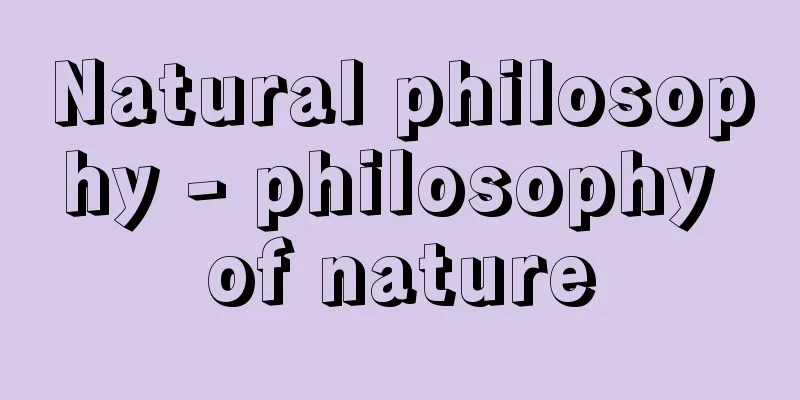Natural philosophy - philosophy of nature

|
The term generally refers to theoretical and philosophical theories about the natural world, but is mainly used to refer to those that existed before the establishment of modern natural science. It is also called physical science (Greek). [Teruo Yokoyama] The Establishment of Natural PhilosophySince the birth of mankind, various things have been known about the natural world through experience, but with the establishment of ancient civilizations, these things were incorporated into an intellectually consistent explanatory system. Initially, these took the form of mythological or literary stories, such as stories about the creation of the universe, but when these were critically and logically examined, and theoretical and systematic explanations were given by eliminating anthropomorphic and narrative elements from the explanations of the natural world, natural philosophy was established. In ancient Greece, natural philosophers, beginning with Thales, proposed various theories about the elements that make up the universe, which were summarized into the theory of the four elements: earth, water, air, and fire. Nature was grasped as a whole as organic and living, and was understood in a unified manner through a teleological perspective. In this natural philosophy perfected by Aristotle, the geocentric theory was adopted, and the Earth was considered to be at the center of the universe. All natural objects were considered to be in the process of realizing their true nature, and for living things, the realization of their true nature was to become a parent, for smoke, to move upward, and for water, to move downward. This natural philosophy, which Aristotle's theories were introduced to the Islamic world and medieval Europe, was widely accepted there, and became the dominant natural philosophy in those regions before modern science. In ancient Greece, there was also a mechanical natural philosophy that taught atomism, but it was considered to be atheistic and to deny religion, and did not spread widely. Ancient India and China also developed their own unique natural philosophies. As in Greece, India also put forward various theories about the elements that make up the universe, and atomistic theories also emerged. In China, atomistic theories were almost nonexistent, and an organic view of nature was mainstream. They explained the creation of the natural world through the theory of Yin-Yang and the Five Elements, and attempted to understand the composition of all things through reason and qi. This Chinese natural philosophy was also introduced to Japan, and Miura Baien of the Edo period created his own unique system of natural philosophy. [Teruo Yokoyama] Modern Science and Natural PhilosophyAs modern science developed in Europe from the 17th century onwards, the traditional natural philosophy that existed before that time came to be rejected as speculation without experimental or empirical evidence, and the term natural philosophy became less used. Modern science takes an atomistic and mechanistic view of nature, and so in the first half of the 19th century, mainly in Germany, Schelling and others argued for an organic view of nature in opposition to modern science. This theory is sometimes called natural philosophy in particular. [Teruo Yokoyama] "The Idea of Nature" by Collingwood, translated by Yasuyuki Hirabayashi and Tadahiro Onuma (1974, Misuzu Shobo)" ▽ "Science in Civilization" by Shuntaro Ito (1976, Keiso Shobo)" ▽ "Scientific Civilization in China" by Kiyoshi Yabuuchi (Iwanami Shinsho)" ▽ "Scientific Thought in Japan" by Tetsuo Tsuji (Chuko Shinsho) Source: Shogakukan Encyclopedia Nipponica About Encyclopedia Nipponica Information | Legend |
|
自然界についての理論的・哲学的学説を一般的にさすが、主として近代自然科学成立以前のものについていわれる。自然学physica(ギリシア語)ともいう。 [横山輝雄] 自然哲学の成立人類誕生以来、自然界について経験的にいろいろなことが知られてきたが、古代文明の成立とともに、それらは知的な一貫した説明体系のなかに組み込まれた。当初それらは宇宙創成物語等の神話的・文学的形態をとっていたが、それを批判的・論理的に検討し、自然界の説明から擬人的・物語的要素を排除して理論的・体系的な説明が与えられるようになって、自然哲学が成立する。 古代ギリシアにおいて、タレスに始まる自然哲学者たちは、宇宙の構成元素についてさまざまな学説を提出し、それらは、土、水、空気、火の四大元素説へとまとめられた。自然は全体として有機的・生命的なものとして把握され、目的論的な見方によって統一的に理解された。アリストテレスによって完成されたこうした自然哲学においては、天動説が採用され、地球は宇宙の中心にあるとされた。あらゆる自然物は、その本性を実現する過程にあるとされ、生物にとっては親になること、煙にとっては上方へ移動すること、水にとっては下方へ移動することがその本性の実現であるとされた。このような自然哲学は、アリストテレスの学説がイスラム世界や中世ヨーロッパ世界に伝えられ、そこで広く受容されたため、それらの地域でも近代科学以前の支配的自然哲学となった。古代ギリシアには、原子論を説く機械論的な自然哲学も存在したが、それは無神論であり、宗教を否定するものであるとみなされ、一般には広がらなかった。 古代インドや中国も、それぞれ独自の自然哲学を発達させた。インドでもギリシアと同様に、宇宙の構成元素についてのいろいろな学説が提出され、また原子論的な学説も現れた。中国では原子論的な学説はほとんどみられず、有機的自然観が主流であった。陰陽五行説によって自然界の生成を説明し、理と気によって万物の構成を理解しようとした。こうした中国の自然哲学は日本にも伝わり、江戸時代の三浦梅園は独自の自然哲学の体系をつくりあげた。 [横山輝雄] 近代科学と自然哲学17世紀以降ヨーロッパで近代科学が展開されると、それ以前の伝統的自然哲学は、実験的・実証的根拠をもたない思弁であるとして否定されるようになり、自然哲学ということばもあまり使われなくなった。近代科学は、原子論的・機械論的な自然観をとっており、そのため19世紀前半のドイツを中心に、シェリングらによってそれに反対して有機的自然観が主張された。その学説がとくに自然哲学とよばれることもある。 [横山輝雄] 『コリングウッド著、平林康之・大沼忠弘訳『自然の観念』(1974・みすず書房)』▽『伊東俊太郎著『文明における科学』(1976・勁草書房)』▽『藪内清著『中国の科学文明』(岩波新書)』▽『辻哲夫著『日本の科学思想』(中公新書)』 出典 小学館 日本大百科全書(ニッポニカ)日本大百科全書(ニッポニカ)について 情報 | 凡例 |
>>: Natural levees - Shizen teibou
Recommend
Monokine
...The main ones are macrophage (migration) inhib...
Dermatology - Hifuka
It is a branch of clinical medicine that deals wi...
Pelodrydidae
...A general term for frogs of the Hylidae family...
Iekakebayashi - Iekakebayashi
...Recently, with the decline in the number of fa...
Diogenes of Sinope (English spelling)
Greek philosopher from 400 to 325 BC. A representa...
Tonometer - Gunatsukei
A device for measuring intraocular pressure. It pr...
Rennyo
A monk from the Muromachi period. He was the 8th ...
Pongee
…It is made by weaving raw silk from the tussah s...
Kamo Wakeikazuchi no Mikoto (Kamo Wakeikazuchi no Mikoto)
The deity worshipped at Kamo Wakeikazuchi Shrine (...
Epacrisidae - Epacrisca
…Ericaceae shrub (illustration) similar to the Er...
Fagopyrum cymosum (English spelling) Fagopyrum cymosum
…[Yoshiharu Iijima]. … *Some of the terminology t...
Sclera
It is a white, opaque membrane that occupies most...
Sauvage (English spelling) François Boissier de Sauvage
1706‐67 Professor of medicine and botany at the Un...
Steinbock (English spelling)
A small antelope with a slim, slender body. A mamm...
Yenching Research Institute - Yenching Research Institute
…Today, as President Elliott said, it is still co...









